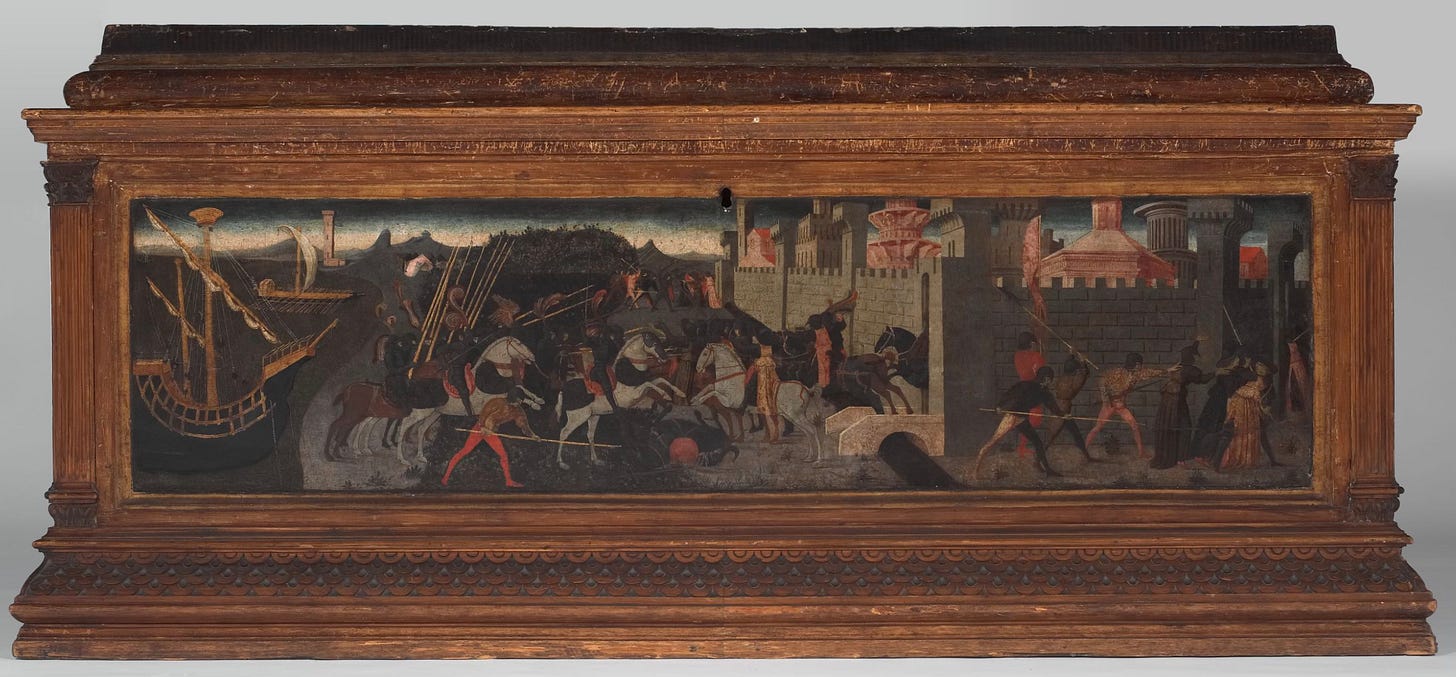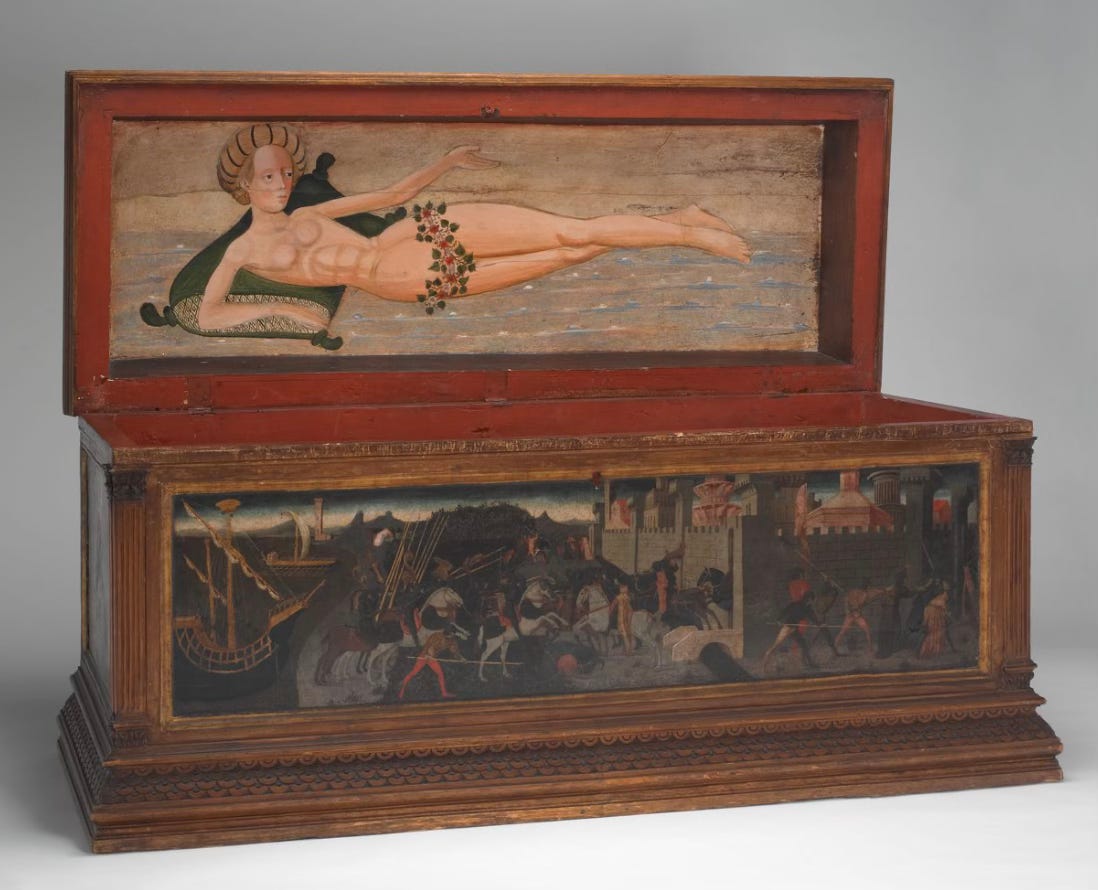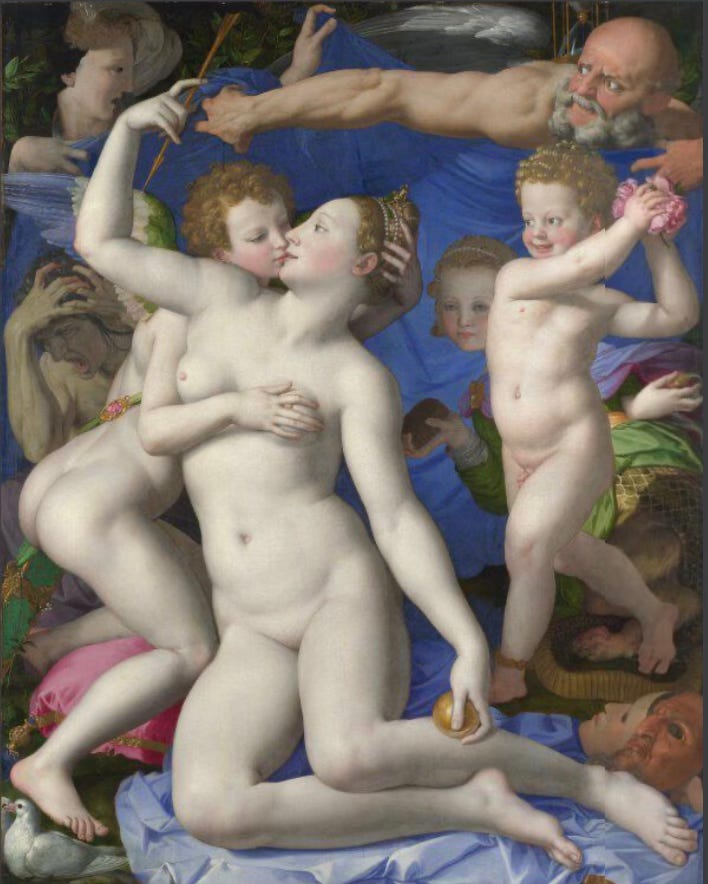Private Parts of the Cassoni
Epic poetry on the outside, sexy nude on the inside! Helping to make babies (ahem, boy babies) in Renaissance Florence. Plus an erotic link between Venus and Cupid (!).
Happy early Spring! Today is the third of four planned in my mini-series, so I’m here to warm you again with the fiery flames of love in Renaissance Florence. I can’t leave the subject of cassoni without giving you a look at the paintings hidden under the lid. Bring your fans for this potentially steamy subject, and wear your most clutchable pearls! I jest—what you should actually bring is your imagination. Keep reading to see how these paintings would have been seen in the time and place of their creation, and I’ll end with a closer look at one of the most charming, funny examples.

As you remember from my post dated February 28, cassoni are painted chests from early 15th century Florence, commissioned on the occasion of a grand wedding and carried through the streets during the wedding procession. The stories pictured on the outside were meant to commemorate the joining of aristocratic families, celebrate love within marriage, and inspire moral excellence. The painted panels on the front often illustrated poetic works such as the Triumph of Love by Petrarch or events from classical mythology. The wedding chest would then be placed in the matrimonial bedchamber to hold linens, fabrics, and other household materials. There, in the more intimate space of the bedroom, the cassone would be opened to reveal, painted on the inside of the lid: a full-length reclining nude! Ooo la la!

OK, you might be thinking, what’s the big deal? Most of us familiar with the western art tradition are used to seeing nudes in paintings or sculpture in an art gallery—sculptures from Greece and Rome by the thousands showcase the human form, which became the basis of study in European painting academies from the 16th through the 19th century to today. But these cassoni paintings date from the early Renaissance, generally from the first half of the 15th century, coming out of the medieval period when (speaking generally) artists did not base their studies on observations of the naked human. There was still a good deal of what they would call modesty and what we might call prudishness, as attitudes about nudity have swung back and forth since Adam and Eve realized they were naked. Anyway, seeing these particular nudes that survive today, you might argue that the artists didn’t have much experience studying the human form themselves—even when they came out of the studios of extremely talented and cutting-edge Florentine artists.

So, how did this tradition of painting nudes on the inside of cassoni arise? In early modern Europe, the institution of marriage was about joining families together for economic and social purposes, and to produce babies—particularly baby boys—to continue the family line. Think of Romeo and Juliet again— family groups were the main institution that wielded great power in Shakespeare’s Verona. The Capulet family was not going to let Juliet marry for mere love, which could be an acceptable by-product within marriage but not a reason for it. Paintings could help inspire the flowering of love in such an arranged marriage, and specifically love-making. In Renaissance Florence, it was thought that the act of seeing erotic images would lead directly to the creation of baby boys, a necessity to help continue the legacy of the aristocratic family. And if perpetuating the family line meant inspiring baby-boy-making, a little super-soft porn to get the action started could be really important. You could argue that on the one hand, these cassoni paintings might have only secondarily served erotic purposes, remaining primarily moralizing and didactic. On the other hand, maybe that was an excuse to hide sexy nudes under the lid, with a byproduct of helping begin a familiarizing of the studying of the human form that would soon become a characteristic of the humanism of Renaissance art making.

Remember how Vasari said these cassoni were in the shape of a sarcophagus? (I quoted him in my previous post defining cassoni.) A box merely meant to hold textiles could have been just any shape, but putting a full-length human reclining figure meant that cassoni proportions had to accommodate this tradition. I’m inclined to think that the form of the cassoni box was interconnected with the intention of including the nude. Most of the examples that survive depict female nudes, but there are some male nudes, too, for those his/hers sets.

I alluded to the cassoni tradition in my post on the lid to the harpsichord by Giulio Sanuto after Bronzino—open it and there are all these fit male nudes, awakening and tightening the senses in anticipation of the music. Bronzino would have known of the tradition of nudes on the inside of lids of wooden boxes. There are scores of paintings of reclining female nudes from the later Renaissance, from the early 16th century and on, that also come out of this tradition—so many that I’m sure we will return to this theme here at The Vivid Eye.
Not ALL cassoni interior painted panels that survive show reclining nudes—the scholar Ellen Callman noted that there are two other categories of subject that decorate inside the lid.* One was a painted fictive textile pattern, probably the cheapest way to decorate the interior, as this could be painted by a workshop assistant. Still, the fabric chosen to replicate among the surviving cassoni panels that I’ve seen mimic very rich textiles, glorious double-pile velvets with golden threads, fabrics that would have been much more expensive than a painting at the time. Though it may have been the cheaper option, it would have provided some delight at the idea of paint being able to imitate fabric.
The other category is of frolicking babies, often with coats of arms of the families, representing the two families joining together and hopefully producing baby boys who could continue the family name.

Now as promised, let’s take a closer look at a cassone lid panel. This one has both a reclining frontal female nude AND a playful baby boy! It includes some fine linen textiles as well, checking all three of the categories mentioned by Callman. In this case, the nude is no ordinary pretty blond, but Venus, Goddess of Love, and the naked boy with red-hot wings must be her son Cupid, or Eros. As so many cassone panels were, it was separated from its box and framed to hang as a painting on the wall.

Venus and Cupid play a gentle tug of war with a garland of roses—but this is more than just play. Comparing the rosy garland with the flowers of modesty over the image from Ucello’s workshop cassone above, it seems that the rosy garland could have originally covered her pudenda and Cupid has cheekily snatched it away. He grasps the garlanded girdle with two hands and pulls, and Venere is no longer pudica. Flimsy cover though a garland of flowers might have been, now the viewer has full visual access to her shapely form. You could imagine this being quite a teasing scene for newlyweds to see Love, personified playfully, removing barriers to access of Venus’ secret parts.
Several other formal qualities are delightfully sexy about this cassone panel lid. The white-tipped waves of the sea in the background (alluding to Venus‘s birth from the sea) are shown and undulating in a back-and-forth motion. Venus semi-reclines on fertile ground, which sprouts tufts of grass and violet leaves with itty-bitty flowers; the three pillows covered with a cloth (perhaps mirroring the contents of the cassone) make her lounging on the ground a little bit more comfortable. I’m not sure, but the two colors of the blue and red pillows might allude to two different heraldic symbols of the families united by the wedding. Venus also has the most gossamer of veils across her upper thighs, which hides virtually nothing, becoming very effective lingerie. Her hair is dyed blond, with an exaggeratedly high (plucked) forehead worn by the aristocratic ladies in quattrocento Florence.
I really love Cupid’s stance as he braces his legs for stability as he pulls (with some foreshortening in his left foot) as though he is coming into a yoga pose. The bright red of his wings carries throughout the panel, across in the rose garland and over to the red of two of Venus‘s pillows. Note that mother and son are making direct eye contact—there’s definitely some erotic tension between the winged toddler Cupid and his mother, Venus.**
With greater sophistication than in some other contemporary panel paintings, the artist of this inner lid, Paolo Schiavo, has observed the human forms more subtly, using shading on the torso and instead of lines and the subtle swells of the arms and legs, the delicate toes, even the rise of Cupid’s left buttock. Despite her overly small head—perhaps a last-minute constraint of the panel’s edge—Venus’s gesture is as graceful as her tapering limbs. I don’t know if she can hold that pose with her hips towards the viewer for very much longer, underscoring the idea that the female form is on display—when the chest is open—she tilts up her hips in an action that rhymes with the opening up of the lid of the box.
Thank you for joining me on this deeper look inside the cassoni of Renaissance Florence! Please leave a comment if you want to know more about something. Also, I’ll be hosting a live chat next week on your own experience living with material objects of love and marriage—pencil in April 4—hope to meet you there!
And finally…
References and an Absolutely Zany and Gorgeous Bonus Painting—now you’ll be glad you brought your pearls and fans:
*Ellen Callman in “An Apollonio di Giovanni for an Historic Marriage.” Berlington Magazine 119, March 1977, p. 174-181 quoted in Art and Love in Renaissance Italy p. 134
**An eroticism between Venus and Cupid—despite the filial relationship—occurs elsewhere in Italian painting, the most wild of which is probably The Allegory of Venus and Cupid by Bronzino—yes, the same painter of the Apollo and Marsyas harpsichord cover I spoke of earlier. There is a LOT going on in this painting, and art historians love to talk about its various interpretations. Remember, it is an Allegory with lots of symbolism, so there isn’t a single “right” answer!

If you’d like to know more, let me know! To start, there’s an excellent introduction on the website of the National Gallery: https://www.nationalgallery.org.uk/paintings/bronzino-an-allegory-with-venus-and-cupid




